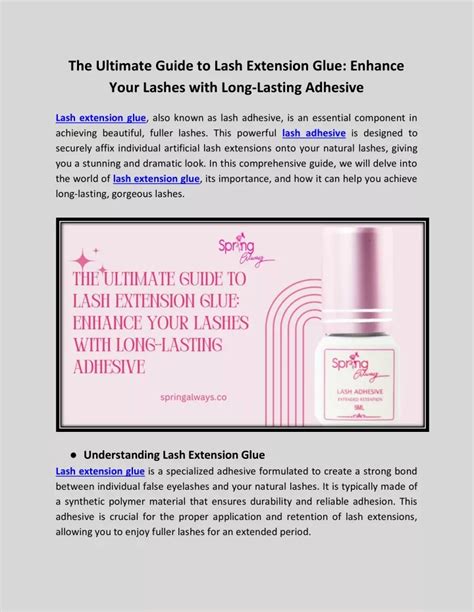Introduction

Glue-in extensions are a popular hair extension method that offers long-lasting volume and length. They involve using a strong adhesive to attach individual hair strands to your natural hair. While glue-in extensions can provide stunning results, it’s essential to understand the technique, maintenance, and potential drawbacks before making a decision.
Types of Glue-In Extensions
There are two primary types of glue-in extensions:
- Keratin Extensions: Made from human hair or synthetic fibers, keratin extensions are bonded using a heated keratin-based glue.
- Pre-Tipped Extensions: These extensions come with pre-glued tips that can be heated and fused to your natural hair.
Pros and Cons of Glue-In Extensions
Pros:
- Long-lasting: Glue-in extensions can last for up to 6 months with proper care.
- Versatile: They can be styled and colored like natural hair.
- Volume and Length: Can add significant volume and length to hair.
- Hair Damage: Minimal damage to natural hair compared to other extension methods.
Cons:
- Professional Installation: Requires a professional stylist for installation and removal.
- Maintenance: Regular appointments are needed for rebonding and maintenance.
- Cost: Glue-in extensions can be expensive to install and maintain.
- Potential for Hair Damage: Improper installation or removal can damage hair.
Installation Process
The installation process involves the following steps:
- Consultation: Your stylist will assess your hair type and desired results.
- Sectioning: Hair is divided into sections to apply the extensions.
- Glue Application: Small amounts of glue are applied to the base of each extension.
- Bonding: Extensions are pressed onto your natural hair using a heating tool to fuse the glue.
- Blending: Extensions are cut and styled to blend seamlessly with your natural hair.
Maintenance
Maintaining glue-in extensions is crucial for their longevity and hair health. Regular appointments are recommended for the following:
- Rebonding: The glue bond may loosen over time, requiring rebonding to ensure secure attachment.
- Scalp Cleansing: Thoroughly cleansing the scalp is essential to prevent buildup and scalp irritation.
- Extension Checkup: A stylist will examine the extensions, rebond as needed, and address any issues.
How to Choose the Best Glue-In Extension Type
The best glue-in extension type for you depends on your hair type and lifestyle.
- Fine Hair: Keratin extensions are recommended to minimize damage and add subtle volume.
- Thick Hair: Pre-tipped extensions provide more volume and support for thicker hair.
- Active Lifestyle: Pre-tipped extensions may be more durable for those who engage in strenuous activities.
Benefits of Glue-In Extensions for Different Hair Types
- Thin or Fine Hair: Adds instant volume and thickness, creating the illusion of fuller hair.
- Thick or Coarse Hair: Provides length and extra support, enhancing the overall texture of the hair.
- Damaged or Over-Processed Hair: Conceals damaged hair and protects it from further breakage.
Important Considerations
- Allergic Reactions: Some individuals may experience allergic reactions to the glue used in extensions.
- Weight: Glue-in extensions can be heavy, which may lead to scalp tension or discomfort.
- Professional Removal: Improper removal can damage natural hair, so professional assistance is advised.
Alternatives to Glue-In Extensions
If glue-in extensions are not suitable for you, there are alternative hair extension methods available:
- Clip-In Extensions: Temporary extensions that clip onto your natural hair.
- Tape-In Extensions: Flat wefts of hair taped to your natural hair.
- Fusion Extensions: Hair strands fused to your natural hair using heat or ultrasonic technology.
Conclusion
Glue-in extensions offer long-lasting volume and length, but require professional installation and maintenance. Understanding the benefits, drawbacks, and installation process is crucial for informed decision-making. By following proper care and maintenance, you can enjoy beautiful and natural-looking hair extensions.
Table 1: Comparison of Glue-In Extension Types
| Feature | Keratin Extensions | Pre-Tipped Extensions |
|---|---|---|
| Adhesive Type | Keratin | Pre-applied glue |
| Application Method | Heated | Heated and pressed |
| Longevity | 4-6 months | 6-8 months |
| Damage to Natural Hair | Minimal | Minimal |
| Cost | Higher | Lower |
Table 2: Maintenance Schedule for Glue-In Extensions
| Task | Frequency |
|---|---|
| Rebonding | Every 6-8 weeks |
| Scalp Cleansing | Weekly |
| Extension Checkup | Every 3-4 weeks |
Table 3: Benefits of Glue-In Extensions for Different Hair Types
| Hair Type | Benefits |
|---|---|
| Thin or Fine | Volume, thickness |
| Thick or Coarse | Length, support |
| Damaged or Over-Processed | Concealment, protection |
Table 4: Effective Strategies for Choosing the Best Glue-In Extension Type
| Factor | Consideration |
|---|---|
| Hair Type | Fine hair: Keratin, Thick hair: Pre-tipped |
| Lifestyle | Active: Pre-tipped, Sedentary: Keratin |
| Budget | Pre-tipped: Lower cost, Keratin: Higher cost |
